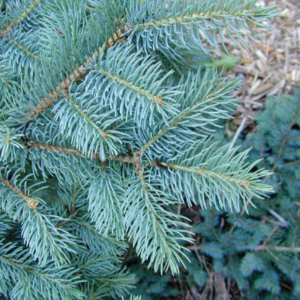 The blue spruce is the official state tree of Colorado and an important streamside species. Their roots stabilize soil, preventing erosion. Their cones provide food for squirrels and nuthatches. Their branches offer shelter and nesting space.
The blue spruce is the official state tree of Colorado and an important streamside species. Their roots stabilize soil, preventing erosion. Their cones provide food for squirrels and nuthatches. Their branches offer shelter and nesting space.
However, these towering trees are threatened by a tiny enemy. The spruce bark beetle is native to Colorado and has long made its home in the trunks of spruce trees, but something has changed. The beetle is now enjoying a competitive advantage over the spruce tree thanks to a warming climate and historic logging practices. Warmer winters mean the beetle can breed more successfully because fewer of their larvae succumb to the cold. Furthermore, much of Colorado’s forests were clear-cut about a century ago. This means that the trees in our mountains today, which replaced those that were logged, are reaching susceptible old-age all at once. We are witnessing a beetle feast.
Dead trees, whether standing or fallen on the forest floor, create important habitat for many species. Standing dead trees offer nesting cavities, shelter and protection for bats, woodpeckers, owls and many other species. Roll over a log on the forest floor and you will find it teeming with invertebrates working diligently to turn the tree trunk back into rich soil.
Unfortunately, dead trees can also fall on cars, homes and across roads, endangering humans and their property. Fallen wood can provide fuel for forest fires that threaten human lives and property further. Some healthy trees can be protected from the beetle with injected or sprayed pesticides, but this can be costly and can have harmful side effects for the insects that pollinate other flowers and live in our streams. Dead spruce trees can be removed, but should be replaced with native plants and their trunks left to return to the soil whenever possible.
Paradoxically, our efforts to save our trees from spruce bark and mountain pine beetles may have brought about another scourge. Pine needle scale (Chionaspis pinifoliae) is another insect whose waxy eggs and young are often visible on the needles of spruce and pine trees close to human development. Interestingly, needle scale is much less prevalent in Colorado forests away from human habitation. Some experts believe that by spraying to mitigate pine beetle and spruce beetle infestations, we eliminated natural predators of the needle scale and unknowingly ushered in the current outbreak.
As is often the case, human efforts to address environmental problems of our own creation have had unintended consequences. Broad-spectrum pesticides that kill many species of insect indiscriminately have impacts on more than the species that applicators are hoping to target. They often eliminate the beneficial bugs too.
One alternative that property owners can use to protect their trees is a pheromone packet that releases a scent message to beetles, essentially telling them that the tree is already “full” of beetles. It is like a “no vacancy” sign that sends the beetles packing. Verbenone packets are effective at deterring mountain pine beetle. For Spruce Beetle, we use a product called MCH which is actually more effective on Douglas fir trees than on spruce trees. Both can be purchased online or purchased and installed by a licensed applicator.
As residents of an active, outdoor community, we are probably more aware of how our actions impact the environment than most. Still, it is easy to overlook how something as simple as spraying a tree for pests or removing dead wood can impact the species that depend on that tree for habitat.
Pete Wadden is the Watershed Education Coordinator for the Town of Vail, and serving as a guest author for Walking Mountains’ Science Center’s Curious Nature column. For more information on recycling, Gore Creek Restoration, and other environmental initiatives in Vail, visit LoveVail.org.








